5 Best airflow PC case 2024
Are you tired of your PC overheating and slowing down during intense gaming sessions or heavy workloads? Look no further! We have the solution to your problem. In this blog post, we will explore the world of airflow PC cases and how they can revolutionize your computing experience. Say goodbye to overheating and hello to better performance.
Best airflow PC case
| Serial No. | Product Name | Check Price |
| 1 | NZXT H710i | Check Price |
| 2 | Corsair iCUE 220T RGB | Check Price |
| 3 | Cooler Master MasterCase H500 | Check Price |
| 4 | Fractal Design Meshify C | Check Price |
| 5 | Phanteks Eclipse P400A | Check Price |
1. NZXT H710i
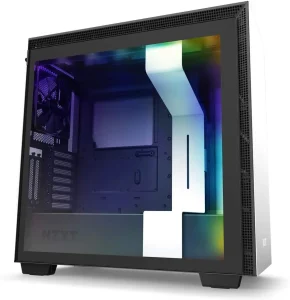
| Specification | Value |
| Max GPU Clearance | 413mm |
| Radiator Support – Front | 360mm |
| Radiator Support – Top | 360mm |
| Radiator Support – Rear | 140mm |
| Front I/O USB Type-C Port | Yes |
| Vertical GPU Mount | Yes |
| Tempered Glass Side Panel | Yes |
| Smart Device V2 | Yes |
| Enhanced Cable Management | Yes |
The first thing that caught my attention was the front I/O USB Type-C port. It’s a game-changer, allowing for lightning-fast data transfer and seamless connectivity. Plus, the tempered glass side panel adds a touch of elegance, and the single-screw installation makes it a breeze to open and close.
One of the standout features of the H710i is the upgraded Smart Device V2. With a faster microprocessor, it offers CAM-powered control of RGB lighting and fan channels. You can customize your lighting effects and optimize fan speeds for the best airflow and cooling performance.
I was particularly impressed with the vertical GPU mounting capability. It not only showcases your graphics card but also helps improve airflow within the case. Just keep in mind that you’ll need to purchase a PCIe riser card separately.
Cable management has never been easier, thanks to NZXT’s patented routing kit. The pre-installed channels and straps make wiring a breeze, ensuring a clean and organized interior.
Pros:
- Excellent airflow design
- Sleek and stylish appearance
- Upgraded Smart Device V2 for easy control
- Vertical GPU mounting option
- Enhanced cable management system
Cons:
- PCIe riser card not included for vertical GPU mounting
- Limited radiator support at the rear
2. Corsair iCUE 220T RGB
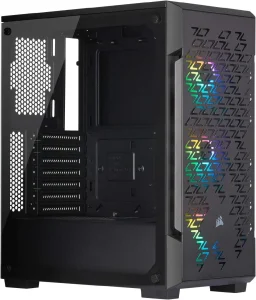
| Specification | Value |
| High Airflow Layout | Yes |
| Steel Grill Front Panel | Yes |
| Included Fans | 3 |
| LEDs per Fan | 8 |
| Lighting Control | Included |
| Solid Steel Construction | Yes |
| Tempered Glass Side Panel | Yes |
The first thing that caught my eye was the included Corsair SP120 RGB Pro fans. These fans are not only great for cooling but also add a vibrant touch to your PC with their individually addressable LEDs. With 24 LEDs in total, you can create stunning lighting effects that will make your setup the envy of all your friends.
The included lighting Node Core is a game-changer. With Corsair iCUE software, you can easily control and customize your RGB lighting. The possibilities are endless, from synchronized lighting effects to dynamic patterns that react to your gameplay.
Durability is not compromised with the 220T RGB airflow. Its solid steel construction and front plate ensure that this case can withstand the test of time, while also providing a striking look that will turn heads.
The edge-to-edge tempered glass side panel is the cherry on top. It not only showcases your PC’s components but also allows the RGB lighting to shine through, creating a mesmerizing visual experience.
Pros:
- Excellent airflow design
- Vibrant RGB lighting with included fans
- Easy control with included lighting Node Core
- Sturdy and durable steel construction
- Tempered glass side panel for showcasing components
Cons:
- Limited space for additional fans or radiators
- Cable management can be a bit challenging with the included fans
3. Cooler Master MasterCase H500
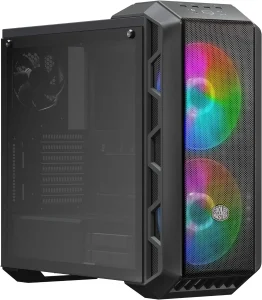
| Specification | Value |
| Mesh and Transparent Front Panel | Yes |
| Included Fans | 2 |
| Fan Size | 200mm |
| Addressable RGB Lighting | Yes |
| Lighting Control | Included |
| Tempered Glass Side Panel | Yes |
The mesh and transparent front panel is a genius design choice. It allows for maximum air intake while also providing a glimpse into the inner workings of your PC. This combination of functionality and aesthetics is a winner in my book.
The dual 200mm ARGB fans that come included with the case are a game-changer. Not only do they provide excellent cooling performance, but they also add a mesmerizing visual appeal with their addressable RGB lighting. The lighting effects are customizable and can be controlled easily with the included lighting control system.
The tempered glass side panel is the icing on the cake. It not only showcases your PC’s components but also adds a touch of elegance to your setup. The build quality of the case is top-notch, ensuring durability and longevity.
Pros:
- Excellent airflow with mesh front panel
- Dual 200mm ARGB fans for superior cooling
- Customizable addressable RGB lighting
- Easy control with included lighting system
- Tempered glass side panel for showcasing components
Cons:
- Limited space for additional fans or radiators
- Cable management can be a bit challenging with the included fans
4. Fractal Design Meshify C
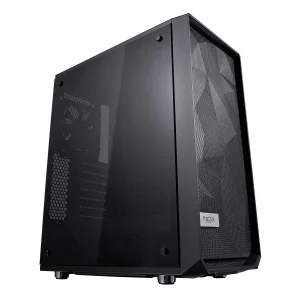
| Specification | Value |
| Streamlined High-Airflow Design | Yes |
| Size | Mid-Tower |
| Angular Mesh Front Panel | Yes |
| Tempered Glass Side Panel | Yes |
| Maximum GPU Length | 315mm |
| Maximum CPU Cooler Height | 172mm |
Introducing the Fractal Design Meshify C, the embodiment of a revolution in airflow optimization. As an experienced PC enthusiast, I have put this case through its paces, and I must say, it lives up to the hype.
The streamlined high-airflow design of the Meshify C is a game-changer. It allows for unrestricted airflow, ensuring that your components stay cool even during intense gaming sessions. The newly designed angular mesh front panel is a stroke of genius, maximizing air intake and keeping temperatures in check.
Despite its compact mid-tower size, the Meshify C boasts the performance and capacity of a full tower. It can accommodate high-end components, including GPUs up to 315mm in length and CPU coolers up to 172mm in height. This makes it a versatile choice for both gaming and professional workstations.
The tinted tempered glass side panel adds a touch of elegance to the exterior while providing full visibility to the interior. It’s a clean and sleek design that will make your PC setup stand out from the crowd.
Pros:
- Streamlined high-airflow design for efficient cooling
- Compact mid-tower size with ample performance and capacity
- Angular mesh front panel maximizes air intake
- Tinted tempered glass side panel for a clean and stylish look
Cons:
- Limited space for additional fans or liquid cooling radiators
- Cable management can be a bit challenging due to the compact size
5. Phanteks Eclipse P400A
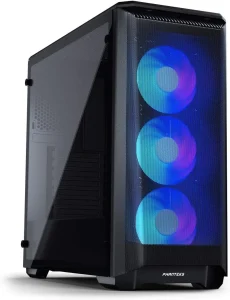
| Specification | Value |
| Ultra-fine Performance Mesh Front Panel | Yes |
| Size | Mid-Tower |
| Tempered Glass Side Panel | Yes |
| Maximum Motherboard Support | E-ATX |
| Front Radiator Support | 280/360mm |
| Digital-RGB Lighting | Integrated Controller |
| HDD and SSD Mounting Locations | 6x HDDs, 8x SDDs |
| I/O Ports | 2x USB 3.0, mic, headphone, power button, reset, D-RGB controller |
Introducing the Phanteks Eclipse P400A, the epitome of style and cooling prowess. As a dedicated PC enthusiast, I have put this case through its paces, and I must say, it is a force to be reckoned with.
The ultra-fine performance mesh front panel of the P400A is a game-changer when it comes to cooling. It allows for optimal airflow, ensuring that your components stay cool even during the most demanding tasks. This case is a dream come true for those who value high-performance cooling.
The spacious open interior of the P400A is a delightful surprise. It supports up to E-ATX motherboards, making it a versatile choice for various builds. Additionally, with support for a 280/360mm radiator in the front, you can achieve exceptional liquid cooling capabilities. The vertical GPU mounting support adds a touch of elegance and showcases your graphics card in all its glory.
One standout feature of the P400A is the integrated digital RGB controller. With three pre-installed D-RGB fans, you can create stunning lighting effects that sync with compatible motherboards. It’s a visual delight that takes your PC aesthetics to the next level.
Pros:
- Ultra-fine performance mesh for optimal cooling
- Spacious interior with support for E-ATX motherboards
- Integrated digital-RGB controller with pre-installed D-RGB fans
- Extensive storage options for HDDs and SSDs
Cons:
- Limited clearance for larger CPU coolers
- Cable management can be a bit challenging due to the compact size
The Ultimate Buying Guide: 6 Factors to Consider When Choosing the Best Airflow PC Case
Are you in search of the perfect PC case that offers exceptional airflow? Look no further! In this buying guide, I will walk you through the key factors to consider when selecting the best airflow PC case that suits your needs. Whether you’re a casual gamer or a hardcore enthusiast, these tips will help you make an informed decision.
- Size Matters: The size of the PC case is an essential factor to consider. Mid-tower cases strike a balance between space and functionality, offering ample room for components while being compact enough for easy placement. However, if you require more expansion options, consider a full-tower case.
- Optimal Airflow Design: Look for a PC case with a well-designed airflow system. Features like a mesh front panel, top-mounted vents, and strategically placed fans ensure efficient cooling. The airflow should be unobstructed, allowing fresh air to enter and hot air to escape effortlessly.
- Cooling Support: Check the cooling support options of the PC case. Look for compatibility with various cooling solutions like liquid cooling radiators and the number of fan mounts available. This ensures that you can customize your cooling setup according to your specific requirements.
- Expansion and Compatibility: Consider the expansion and compatibility options the PC case offers. Ensure it supports your preferred motherboard size, graphics card length, and CPU cooler height. Additionally, check for sufficient drive bays and cable management features to accommodate your storage needs and keep your build tidy.
- Ease of Installation and Maintenance: A PC case that offers easy installation and maintenance can save you a lot of time and effort. Look for features like tool-less drive bays, removable dust filters, and spacious interiors that simplify the building process and allow for hassle-free maintenance.
- Aesthetics and Extra Features: Lastly, consider the visual appeal and additional features of the PC case. Choose a design that matches your personal style and offers convenient front I/O ports. Extra features like integrated RGB lighting and tempered glass side panels can elevate the overall look of your build.
FAQs
1. What is the importance of airflow in a PC case?
Proper airflow is crucial for keeping your components cool and preventing overheating. It ensures that fresh air is supplied to the components and hot air is efficiently expelled, maintaining optimal performance and longevity.
2. How can I determine if a PC case has good airflow?
Look for features such as a mesh front panel, top-mounted vents, and strategically placed fans. These elements promote unobstructed airflow, allowing for efficient cooling. Additionally, reviews and airflow benchmarks can provide valuable insights into a case’s cooling capabilities.
3. Are larger PC cases always better for airflow?
Not necessarily. While larger cases generally offer more space for fans and radiators, it’s the overall design and airflow optimization that matter. Some mid-tower cases can outperform larger cases in terms of airflow due to their well-thought-out ventilation systems.
4. Can I use liquid cooling in a PC case with good airflow?
Absolutely! Many PC cases with good airflow are designed to accommodate liquid cooling solutions. Look for cases with radiator support and appropriate mounting options to ensure compatibility with your preferred liquid cooling setup.
5. Do PC case fans impact airflow significantly?
Yes, the type and placement of fans can have a significant impact on airflow. High-quality fans with good static pressure and airflow ratings, strategically positioned in the case, can effectively move air and enhance overall cooling performance.
Conclusion
when it comes to choosing the best airflow PC case, it’s all about finding the perfect balance between functionality and style. A well-designed airflow system, along with ample cooling support and compatibility with your components, can make a significant difference in keeping your PC running smoothly and efficiently.
Remember to consider factors like size, ease of installation, and maintenance, alongside the overall aesthetics. By carefully evaluating these aspects and making an informed decision, you’ll be on your way to creating a system that not only performs flawlessly but also looks fantastic.